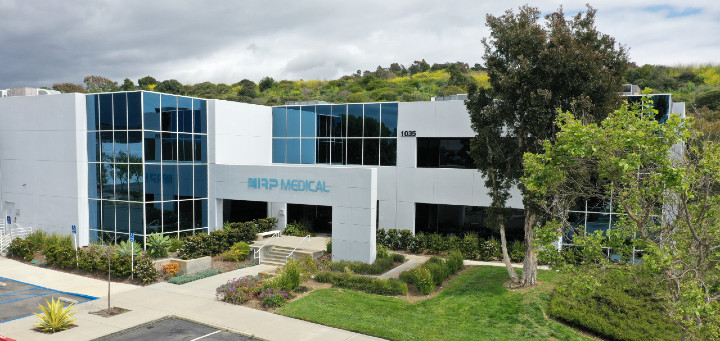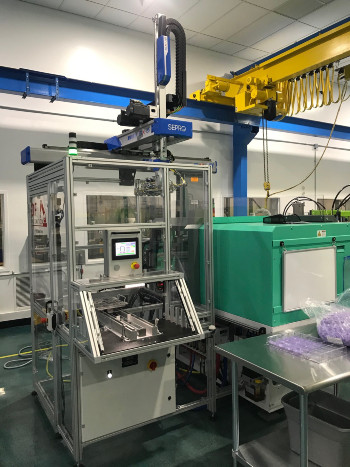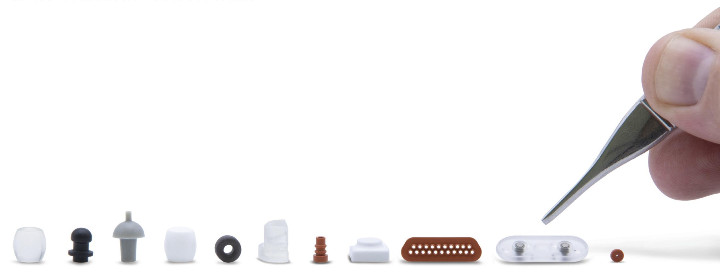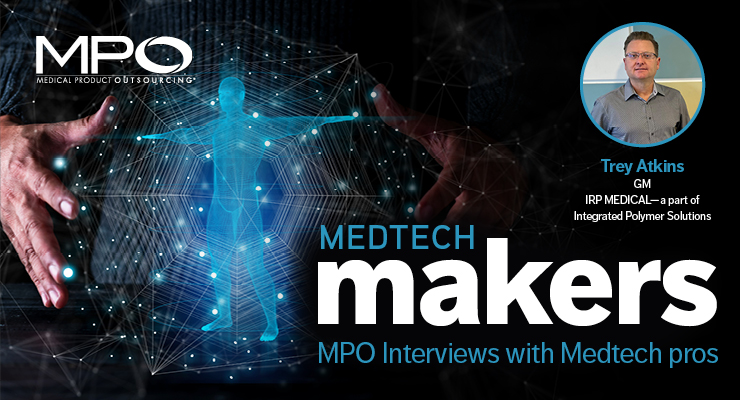By Sean Fenske, Editor-in-Chief
The pandemic has wreaked havoc on supply chains across almost every industry. The medical device sector was not spared. In fact, due to increased demand for a variety of healthcare products, the industry is perhaps facing even greater challenges than ever before. Shortages of materials, sub-assemblies, electronics, and components are causing delays in medtech OEMs being able to fulfill orders.
Coupled with labor challenges similarly affecting the industry, silicone suppliers are strained to maintain production. This has been felt in many areas of healthcare as the material is used for a variety of applications. As such, suppliers of silicone components have had to create their own solutions for addressing a shortage of supply.
Sharing how his company is addressing these problems, Trey Atkins, GM of IRP MEDICAL—a part of Integrated Polymer Solutions—took time to respond to a number of questions. He speaks to issues of the supply of silicone, the impact of the labor shortage,

40,000 sq. ft. manufacturing facility with ISO 7 and 8 cleanrooms.
Sean Fenske: Every aspect of medical device manufacturing is encountering supply chain issues, but can you tell me the specific challenges involved with silicone material?
Trey Atkins: There is a global shortage on supply of silicone material where OEM silicone manufacturers are having difficulty on sourcing the basic materials to manufacture silicone. Some manufacturers declared force majeure, some placed their material supply on allocation, and all of them increased their lead times—almost double from where it was—and, of course, prices have gone up significantly. Couple this with current supply chain problem of moving product from overseas to our seaports and land transport challenges; it is a big problem at hand for all of us in the medical industry.
Fenske: How do the labor issues couple with this in terms of finding the right people to work with silicone?
Atkins: Since we operate on a 24/7 work schedule, we find the pool of interested hourly workers to be in limited supply. The labor market today is very tight, especially when searching for personnel with targeted, skill-specific talent. There are not many experienced silicone and rubber molding process engineers out there. We are searching for additional experienced process engineers in order to enhance our ability to speed up new product launches during these challenging times.
We also instituted an in-house training initiative for developing our pool of process technicians and junior engineers to rapidly build excellence/expertise on liquid silicone processing and execution of new product/process development.

An automated cell used for over molding of plastic components.
Fenske: How do these problems impact medical device manufacturers in terms of their ability to get new products to market?
Atkins: New products to market will inevitably take longer due to shortages in raw materials and lead times for such materials. Our tooling vendors lead times are taking longer as they have resource constraints. In addition, demand is at or above pre-pandemic level, placing constraints on existing tool fabrication and compounding equipment.
Fenske: Can you share some of the material-focused solutions IRP uses to address these challenges, such as waste-free molding and design for manufacturability?
Atkins: We are focused on providing continued assurance of supply to all our valued customers. Pre-pandemic, it was rare for a medical OEM to want to look at or test alternative materials due to high cost and time for qualification. Unfortunately, these times are unprecedented and many OEMs need to protect their business, as well as invest in alternative materials to avoid a shutdown situation. We’ve engaged and delivered several waste-less processes to support high quality and become less reliant on supply chain constraints and human capital. For example, we have over 53 percent of our LIM presses set-up with robots for part extraction. Additionally, we are continuously working on projects to improve our throughput and optimize our raw material consumption.
Fenske: You mention using robots for your component fabrication processes. Have you found other ways to leverage automation to help alleviate some of the concerns brought on by the shortage of labor?
Atkins: Yes. We built fully automated waste-less molding systems with high cavitation, automatic product removal from the mold and from the runner. These systems also feature engineered flash and gate extension, combined with in-line, high resolution cameras for product visual inspection for every part. The fully automated manufacturing systems eliminate the conventional method of having a press operator who removes the shot from the mold then removes product from runner, cryogenic deflashing, and 100 percent human visual inspection.

Critical-To-function custom elastomeric solutions.
Fenske: How does IRP further address cost issues such as your unique approach to ownership of the mold base? How does this also impact lead times?
Atkins: One way is we are changing our mindset regarding tooling for mass production opportunities where we need to produce the best quality product regardless of a customer’s economics. We are underway with leveraging our tooling vendors to allow us to provide a standard cold deck (waste-less mold base) and only charging for inserts to our customers, essentially reducing overall tooling cost and lead times.
Fenske: Do you have any additional comments you’d like to share based on any of the topics we discussed or something you’d like to tell medical device manufacturers?
Atkins: Our parent company, IPS (Integrated Polymer Solutions), has a global footprint. Fortunately, we are able to leverage all of IPS’ current and new technologies to support our customers’ needs. In addition, more than $1 million was invested in 2021 in capital equipment, tooling, and automation; we expect to match that in 2022.
Further, we have shown continuous growth each year through automation projects for new and current scale up production. Also, we keep growing by adding more human capital in Quality, Engineering, and Operations to support our continuous double-digit growth. As a result, our current position enables us to fulfill the needs of our customers—assurance of supply and quality in the midst of the current business environment challenged by the pandemic, silicone material shortage, supply chain issue, labor shortage, and pricing pressure.
Click here to learn more about IRP MEDICAL >>>>>
The pandemic has wreaked havoc on supply chains across almost every industry. The medical device sector was not spared. In fact, due to increased demand for a variety of healthcare products, the industry is perhaps facing even greater challenges than ever before. Shortages of materials, sub-assemblies, electronics, and components are causing delays in medtech OEMs being able to fulfill orders.
Coupled with labor challenges similarly affecting the industry, silicone suppliers are strained to maintain production. This has been felt in many areas of healthcare as the material is used for a variety of applications. As such, suppliers of silicone components have had to create their own solutions for addressing a shortage of supply.
Sharing how his company is addressing these problems, Trey Atkins, GM of IRP MEDICAL—a part of Integrated Polymer Solutions—took time to respond to a number of questions. He speaks to issues of the supply of silicone, the impact of the labor shortage,

40,000 sq. ft. manufacturing facility with ISO 7 and 8 cleanrooms.
Sean Fenske: Every aspect of medical device manufacturing is encountering supply chain issues, but can you tell me the specific challenges involved with silicone material?
Trey Atkins: There is a global shortage on supply of silicone material where OEM silicone manufacturers are having difficulty on sourcing the basic materials to manufacture silicone. Some manufacturers declared force majeure, some placed their material supply on allocation, and all of them increased their lead times—almost double from where it was—and, of course, prices have gone up significantly. Couple this with current supply chain problem of moving product from overseas to our seaports and land transport challenges; it is a big problem at hand for all of us in the medical industry.
Fenske: How do the labor issues couple with this in terms of finding the right people to work with silicone?
Atkins: Since we operate on a 24/7 work schedule, we find the pool of interested hourly workers to be in limited supply. The labor market today is very tight, especially when searching for personnel with targeted, skill-specific talent. There are not many experienced silicone and rubber molding process engineers out there. We are searching for additional experienced process engineers in order to enhance our ability to speed up new product launches during these challenging times.
We also instituted an in-house training initiative for developing our pool of process technicians and junior engineers to rapidly build excellence/expertise on liquid silicone processing and execution of new product/process development.

An automated cell used for over molding of plastic components.
Atkins: New products to market will inevitably take longer due to shortages in raw materials and lead times for such materials. Our tooling vendors lead times are taking longer as they have resource constraints. In addition, demand is at or above pre-pandemic level, placing constraints on existing tool fabrication and compounding equipment.
Fenske: Can you share some of the material-focused solutions IRP uses to address these challenges, such as waste-free molding and design for manufacturability?
Atkins: We are focused on providing continued assurance of supply to all our valued customers. Pre-pandemic, it was rare for a medical OEM to want to look at or test alternative materials due to high cost and time for qualification. Unfortunately, these times are unprecedented and many OEMs need to protect their business, as well as invest in alternative materials to avoid a shutdown situation. We’ve engaged and delivered several waste-less processes to support high quality and become less reliant on supply chain constraints and human capital. For example, we have over 53 percent of our LIM presses set-up with robots for part extraction. Additionally, we are continuously working on projects to improve our throughput and optimize our raw material consumption.
Fenske: You mention using robots for your component fabrication processes. Have you found other ways to leverage automation to help alleviate some of the concerns brought on by the shortage of labor?
Atkins: Yes. We built fully automated waste-less molding systems with high cavitation, automatic product removal from the mold and from the runner. These systems also feature engineered flash and gate extension, combined with in-line, high resolution cameras for product visual inspection for every part. The fully automated manufacturing systems eliminate the conventional method of having a press operator who removes the shot from the mold then removes product from runner, cryogenic deflashing, and 100 percent human visual inspection.

Critical-To-function custom elastomeric solutions.
Fenske: How does IRP further address cost issues such as your unique approach to ownership of the mold base? How does this also impact lead times?
Atkins: One way is we are changing our mindset regarding tooling for mass production opportunities where we need to produce the best quality product regardless of a customer’s economics. We are underway with leveraging our tooling vendors to allow us to provide a standard cold deck (waste-less mold base) and only charging for inserts to our customers, essentially reducing overall tooling cost and lead times.
Fenske: Do you have any additional comments you’d like to share based on any of the topics we discussed or something you’d like to tell medical device manufacturers?
Atkins: Our parent company, IPS (Integrated Polymer Solutions), has a global footprint. Fortunately, we are able to leverage all of IPS’ current and new technologies to support our customers’ needs. In addition, more than $1 million was invested in 2021 in capital equipment, tooling, and automation; we expect to match that in 2022.
Further, we have shown continuous growth each year through automation projects for new and current scale up production. Also, we keep growing by adding more human capital in Quality, Engineering, and Operations to support our continuous double-digit growth. As a result, our current position enables us to fulfill the needs of our customers—assurance of supply and quality in the midst of the current business environment challenged by the pandemic, silicone material shortage, supply chain issue, labor shortage, and pricing pressure.
Click here to learn more about IRP MEDICAL >>>>>













